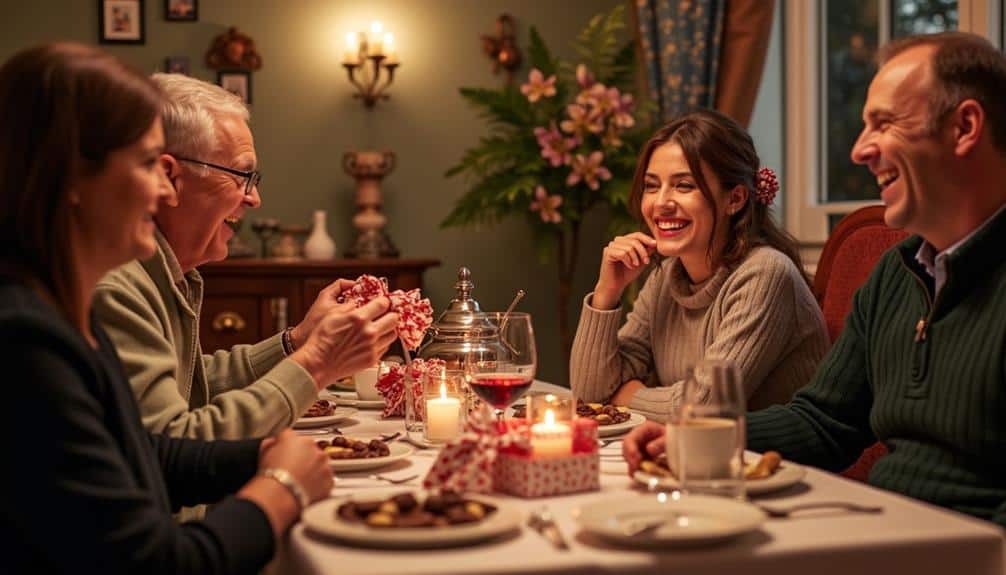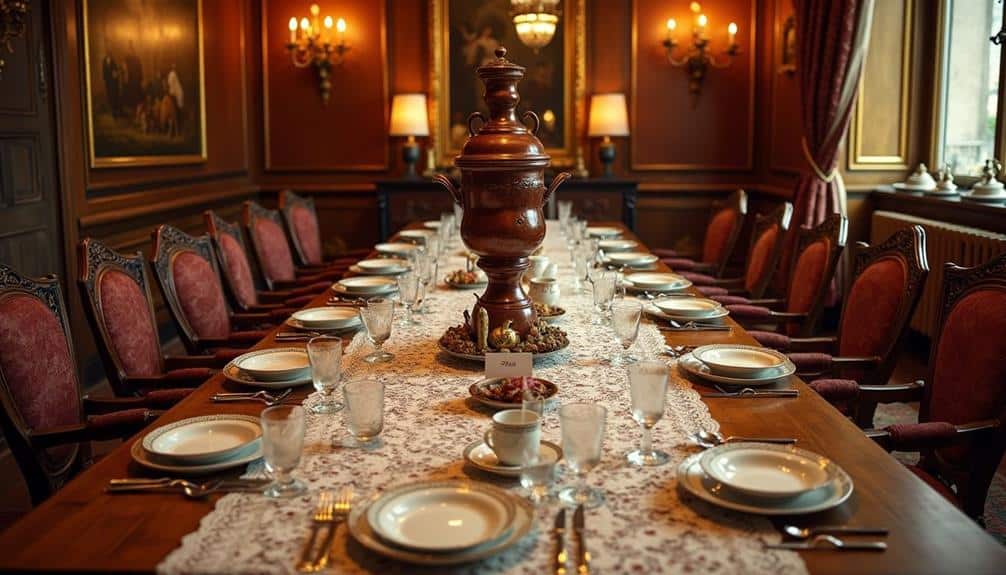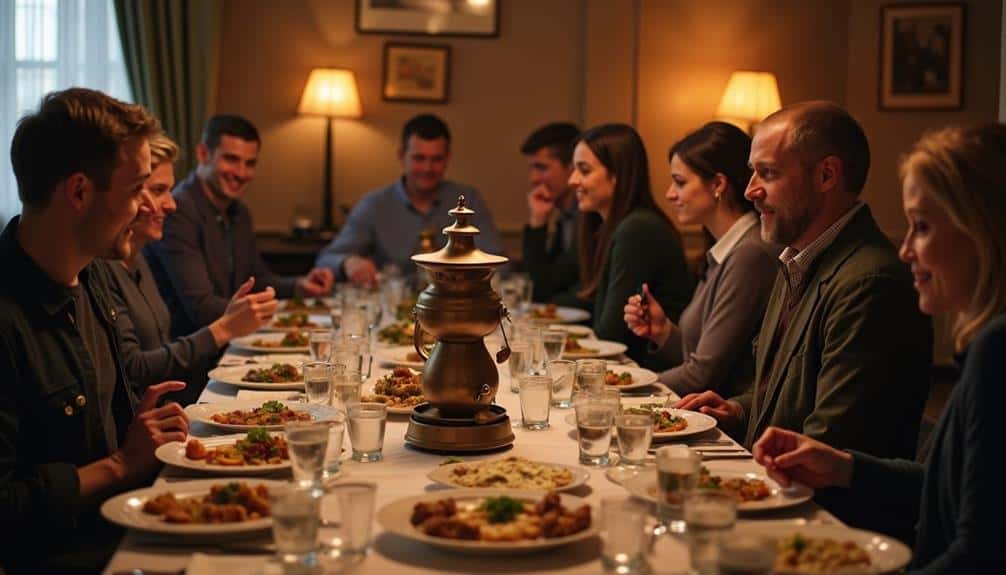Russian dining etiquette, deeply rooted in cultural traditions, offers a fascinating glimpse into the nation’s social customs. Punctuality is paramount, reflecting one’s respect for the host, while attire must align with the formality of the occasion. Guests are expected to bring thoughtful gifts, a gesture that underscores the importance of mutual appreciation. The structured sequence of courses, complemented by meaningful toasts, illustrates the value placed on social bonding. Understanding these practices not only enhances the dining experience but also provides a deeper appreciation for the nuances of Russian hospitality. How do these traditions shape the overall atmosphere of a Russian meal?
Punctuality

Punctuality is a key aspect of Russian dining etiquette that reflects both respect and consideration for the host. In the context of Russian culture, arriving on time is not merely a matter of courtesy but an affirmation of one’s appreciation for the host’s efforts.
The arrival expectations in Russia are stringent; guests are expected to adhere closely to the stipulated time. Arriving late can be perceived as an affront to the host’s hospitality and meticulous planning.
Effective time management is essential when attending a Russian dining event. It is recommended to allocate ample time for preparation and transit, accounting for potential delays. This practice guarantees that one arrives at the event punctually, thereby honoring the host.
The importance of punctuality is deeply embedded in Russian social customs, signifying a disciplined and respectful mindset.
For those who value their personal freedom and autonomy, understanding and respecting these cultural norms can lead to more enriching and harmonious social interactions.
Adhering to the punctuality expected in Russian dining not only demonstrates respect but also enables one to fully appreciate the experience and hospitality extended by the host.
Dress Code
When attending a Russian dining event, it is essential to adhere to the appropriate dress code, as it significantly reflects one’s respect for both the occasion and the host.
Russian gatherings, particularly formal dinners, typically call for elegant and sophisticated attire. Men are generally expected to wear suits or blazers paired with dress shirts, while women should opt for dresses or coordinated ensembles that exude refinement. Formal attire not only establishes the tone of the evening but also aligns with the cultural appreciation for well-dressed guests.
Seasonal styles play a significant role in determining the specific clothing choices. During the colder months, heavier fabrics such as wool or cashmere are advisable, often complemented by stylish coats, scarves, and gloves.
In contrast, warmer seasons invite lighter materials like linen or cotton, allowing for both comfort and elegance. Regardless of the season, the attire should lean towards conservative sophistication, avoiding overly casual or revealing outfits.
Ultimately, dressing appropriately for a Russian dining event signifies an understanding and appreciation of local customs. By embracing formal attire and considering seasonal styles, guests can confidently navigate the social landscape while enjoying the freedom to express personal elegance.
Bringing Gifts

Presenting a gift upon arrival at a Russian dining event is a thoughtful gesture that resonates deeply within Russian culture. Understanding the appropriate gift types and presentation styles can enhance your experience and show respect to your hosts.
It’s customary to bring flowers, but avoid yellow blooms, as they can symbolize a breakup. A bouquet of an odd number of flowers is preferred since an even number is associated with funerals.
Chocolates or high-quality sweets make excellent gifts, reflecting a genuine appreciation for the hospitality extended to you. If you choose to bring alcohol, opt for a fine bottle of wine or high-end spirits, steering clear of vodka unless you are certain of the host’s preferences.
The presentation of the gift is equally important. Wrap your gift neatly, using elegant paper or decorative bags, as this conveys thoughtfulness and care.
When presenting the gift, do so with both hands, maintaining eye contact and offering a few kind words. This respectful exchange underscores the value of your relationship and sets a positive tone for the evening.
Ultimately, the act of bringing a gift, thoughtfully chosen and presented, enriches the cultural experience and honors the tradition of Russian hospitality.
Table Setting
A well-prepared table setting is a hallmark of Russian dining etiquette, reflecting the host’s attention to detail and respect for their guests. The arrangement of tableware types and the precise napkin placement create an inviting atmosphere that encourages guests to feel both honored and comfortable.
In Russian dining, a variety of tableware types are typically used, including multiple forks, knives, and spoons, each designated for specific courses. This often includes a fish fork and knife, a soup spoon, and a dessert fork or spoon. Plates are also layered accordingly, with a smaller plate for appetizers placed on top of the main dinner plate.
Glassware is arranged above the knife, with different glasses for water, wine, and sometimes a vodka glass, reflecting the rich traditions of Russian hospitality.
Napkin placement is equally meticulous. Napkins are often folded elegantly and placed either to the left of the forks or atop the dinner plate. This placement is not only a visual delight but also signals the beginning of the meal.
Guests should wait for the host to unfold their napkin first, setting the tone for the dining experience. This thoughtful table setting underscores the cultural importance of dining as a social and respectful engagement in Russian society.
Seating Arrangements

Just as the table setting reflects the host’s meticulous preparation, seating arrangements are equally significant in Russian dining etiquette. The seating hierarchy, a cornerstone of Russian social customs, guarantees that guests are seated in a manner that respects their social status and fosters harmonious interactions.
Typically, the host and hostess will occupy seats at either end of the table, symbolizing their roles as facilitators of the evening. Guest placement is a task undertaken with great care. Honorary guests, such as elders or individuals of high social standing, are seated closest to the host. This placement signifies respect and acknowledgment of their importance.
Conversely, younger or less distinguished guests are seated further away, ensuring that everyone understands their place within the social fabric of the event. However, there’s a subtle balance to be maintained. While the seating hierarchy must be respected, it should not stifle the freedom of interaction.
Guests are encouraged to engage with one another across the table, fostering a sense of community and conviviality. Thoughtful guest placement, consequently, not only upholds tradition but also enhances the overall dining experience, allowing each attendee to feel honored and included.
Toasting Traditions
Toasting, an integral part of Russian dining etiquette, serves not only as a gesture of goodwill but also as a means to solidify social bonds. In Russia, toasts are not merely formalities; they are heartfelt expressions that often reflect the deep-seated values and emotions of the participants.
Traditional toasts are typically initiated by the host, who sets the tone for the gathering with a few well-chosen words, often celebrating unity, health, and prosperity.
The sequence of toasting is structured and deliberate, with each participant given the opportunity to contribute. Celebratory drinks, usually vodka, are the customary choice, symbolizing purity and strength. However, wine and champagne are also commonly used, especially during festive occasions.
Each toast is accompanied by a clinking of glasses, a ritual believed to ward off evil spirits and guarantee good fortune.
Participants are expected to stand while delivering their toasts, adding a sense of gravitas to the occasion. The content of traditional toasts ranges from personal anecdotes and expressions of gratitude to aspirations for the future.
This practice not only enhances the dining experience but also reinforces the cultural emphasis on community and mutual respect.
Serving Order

While toasting plays a pivotal role in fostering camaraderie, the serving order during a Russian meal is another critical aspect of dining etiquette that underscores respect and tradition. The course progression in Russian dining is meticulously structured to provide a harmonious blend of flavors and textures, enhancing the overall culinary experience.
Typically, the meal begins with appetizers, known as zakuski, which may include an array of smoked fish, caviar, pickled vegetables, and cold meats. These selections are crafted to awaken the palate and prepare guests for the courses that follow.
Soups, such as borscht or solyanka, are the next course, offering a warm and hearty shift.
Main courses often feature robust meats or fish, accompanied by side dishes like potatoes or kasha, ensuring a satisfying and balanced meal. The progression of flavors reaches its peak here, showcasing the richness of Russian cuisine.
Desserts conclude the dining experience, often incorporating sweet and tangy flavor combinations that provide a revitalizing finale.
Adhering to this traditional serving order not only honors Russian customs but also elevates the dining experience, allowing each dish to be fully appreciated in its intended sequence.
Eating Etiquette
Eating etiquette in Russia is imbued with both formality and warmth, emphasizing respect for the host and fellow diners. As you navigate through the meal courses, it is customary to wait for the host to invite you to begin eating. This gesture underscores the importance of the host’s role and sets the tone for a respectful dining experience.
Utensil usage is another critical aspect of Russian dining etiquette. Forks are held in the left hand and knives in the right, and it is considered polite to keep your hands visible yet relaxed at the table. Switching utensils between hands is uncommon and may draw unnecessary attention.
In Russian culture, each meal course is savored, and rushing through them is frowned upon. The first course typically begins with a selection of appetizers, followed by soup, main dishes, and dessert. Each course is an opportunity to engage in meaningful conversation, enhancing the communal dining experience.
Understanding and adhering to these eating etiquette principles not only shows respect but also enriches the dining experience, allowing for a deeper appreciation of Russian hospitality and tradition.
This balance of formality and warmth offers a unique freedom, inviting diners to fully immerse themselves in the cultural tapestry.
Ending the Meal

As the meal progresses toward its conclusion, maintaining the same level of respect and attentiveness is paramount. In Russian dining culture, the way a meal ends holds significant cultural importance. It is customary to guarantee that the host feels appreciated.
Express gratitude for the hospitality and the effort put into the meal. Simple words like “Спасибо” (Thank you) go a long way, and more elaborate expressions of gratitude are also well-received.
The meal conclusion in Russia often includes a final toast, typically given by the host. This is a moment to reflect on the gathering’s purpose and the relationships shared. Participating in this toast shows respect and solidarity with the group.
Additionally, it is polite to leave a small amount of food on your plate, signaling that the meal was plentiful and satisfying.
When it is time to leave, do not rush. Russians value the lingering moments after the meal, which often involve extended conversation and possibly tea or coffee.
This period of winding down is as culturally significant as the meal itself. Embrace this opportunity to deepen connections and fully experience the warmth of Russian hospitality.



